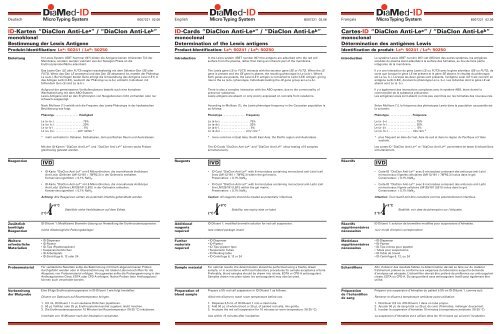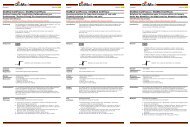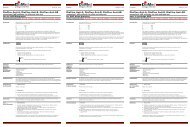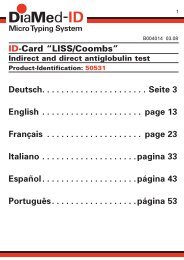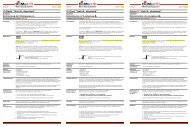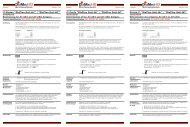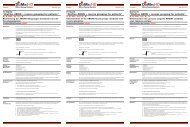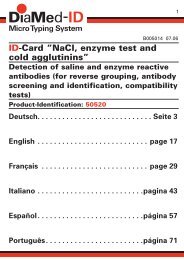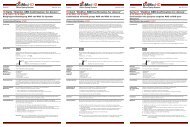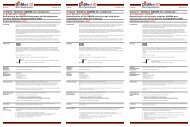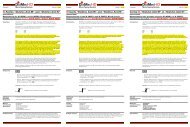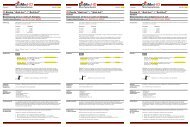ID-Karten “DiaClon Anti-Lea” / “DiaClon Anti-Leb” ID-Cards ...
ID-Karten “DiaClon Anti-Lea” / “DiaClon Anti-Leb” ID-Cards ...
ID-Karten “DiaClon Anti-Lea” / “DiaClon Anti-Leb” ID-Cards ...
Create successful ePaper yourself
Turn your PDF publications into a flip-book with our unique Google optimized e-Paper software.
Deutsch B007221 02.06 English B007221 02.06 Français B007221 02.06<strong>ID</strong>-<strong>Karten</strong> <strong>“DiaClon</strong> <strong>Anti</strong>-Le a ” / <strong>“DiaClon</strong> <strong>Anti</strong>-Le b ”monoklonalBestimmung der Lewis <strong>Anti</strong>geneProdukt-Identifikation: Le a : 50241 / Le b : 50250<strong>ID</strong>-<strong>Cards</strong> <strong>“DiaClon</strong> <strong>Anti</strong>-Le a ” / <strong>“DiaClon</strong> <strong>Anti</strong>-Le b ”monoclonalDetermination of the Lewis antigensProduct-Identification: Le a : 50241 / Le b : 50250Cartes-<strong>ID</strong> <strong>“DiaClon</strong> <strong>Anti</strong>-Le a ” / <strong>“DiaClon</strong> <strong>Anti</strong>-Le b ”monoclonalDétermination des antigènes LewisIdentification de produit: Le a : 50241 / Le b : 50250EinleitungIm Lewis-System (ISBT Nummer 007) bilden die <strong>Anti</strong>gene keinen inhärenten Teil derMembrane, sondern werden vielmehr aus der flüssigen Phase an dieErythrozytenoberfläche adsorbiert.IntroductionIn the Lewis system (ISBT number 007) the antigens are adsorbed onto the red cellsurface from the plasma, rather than being an inherent part of the membrane.IntroductionLe système Lewis (ISBT numéro 007) est différent des autres systèmes, les antigènessolubles du plasma étant adsorbés à la surface des hématies, au lieu de faire partieintégrante de la membrane.Das Lewis-Gen (LE oder FUT3) reagiert wechselseitig mit dem Sekretor-Gen (SE oderFUT2). Wenn das Gen LE anwesend und das Gen SE abwesend ist, ensteht der PhänotypLe (a+b-). Bei Vorliegen beider Gene erfolgt die Umwandlung des <strong>Anti</strong>gens Le(a) (LE1) indas <strong>Anti</strong>gen Le(b) (LE2), wodurch der Phänotyp Le (a-b+) entsteht. Individuen mitfehlendem Gen LE sind Le (a-b-).The Lewis gene (LE or FUT3) interacts with the secretor gene (SE or FUT2). When the LEgene is present and the SE gene is absent, the resulting phenotype is Le (a+b-). Whereboth genes are present, the Le(a) (LE1) antigen is converted to Le(b) (LE2) antigen, givingrise to the Le (a-b+) phenotype. Individuals lacking the LE gene group as Le (a-b-).Il y a une interaction du gène Lewis (LE ou FUT3) avec le gène sécréteur (SE ou FUT2), desorte que lorsque le gène LE est présent et le gène SE absent, le résultat du phénotypeest Le (a+ b-). Lorsque les deux gènes sont présents, l’antigène Le(a) (LE1) est converti enantigène Le(b) (LE2), donnant le phénotype Le (a- b+). Les individus dont le gène LE estabsent sont Le (a- b-).Aufgrund der gemeinsamen Vorläufersubstanz besteht auch eine komplexeWechselwirkung mit dem ABO-System.Lewis-<strong>Anti</strong>gene sind an den Erythrozyten von Neugeborenen nicht vorhanden oder nurschwach ausgeprägt.There is also a complex interaction with the ABO system, due to the commonality ofprecursor substance.Lewis antigens are absent or only poorly expressed on red cells from newborns.Il y a également des interactions complexes avec le système ABO, étant donné lacommonalité de la substance précurseur.Les antigènes Lewis sont absent ou très peu exprimés sur les hématies des nouveau-nés.Nach Mollison [1] verhält sich die Frequenz des Lewis-Phänotyps in der kaukasischenBevölkerung wie folgt:According to Mollison [1], the Lewis phenotype frequency in the Caucasian population isas follows:Selon Mollison [1], la fréquence des phénotypes Lewis dans la population caucasoïde estla suivante:Phänotyp . . . . . . . . . . . . . . . . HäufigkeitPhenotype . . . . . . . . . . . . . . . FrequencyPhénotype . . . . . . . . . . . . . . . FréquenceLe (a- b+) . . . . . . . . . . . . . . . . . . . 75%Le (a+ b-) . . . . . . . . . . . . . . . . . . . 20%Le (a- b-) . . . . . . . . . . . . . . . . . . . 5%Le (a+ b+). . . . . . . . . . . . . . . sehr selten *Le (a-b+). . . . . . . . . . . . . . . . . . . . 75%Le (a+b-). . . . . . . . . . . . . . . . . . . . 20%Le (a-b-) . . . . . . . . . . . . . . . . . . . . 5%Le (a+b+) . . . . . . . . . . . . . . . . very rare *Le (a- b+) . . . . . . . . . . . . . . . . . . . 75%Le (a+ b-) . . . . . . . . . . . . . . . . . . . 20%Le (a- b-) . . . . . . . . . . . . . . . . . . . 5%Le (a+ b+). . . . . . . . . . . . . . . . très rare ** mehr verbreitet in Ostasien, Südostasien, dem pazifischen Raum und Australasien.* more common in East Asia, South East Asia, the Pacific region and Australasia.* plus fréquent en Asie de l’est, Asie de sud et dans la région du Pacifique et l’Asieaustrale.Mit den <strong>ID</strong>-<strong>Karten</strong> <strong>“DiaClon</strong> <strong>Anti</strong>-Le a ” und <strong>“DiaClon</strong> <strong>Anti</strong>-Le b ” können sechs Probengleichzeitig getestet werden.The <strong>ID</strong>-<strong>Cards</strong> <strong>“DiaClon</strong> <strong>Anti</strong>-Le a ” and <strong>“DiaClon</strong> <strong>Anti</strong>-Le b ” allow testing of 6 samplessimultaneously.Les cartes-<strong>ID</strong> <strong>“DiaClon</strong> <strong>Anti</strong>-Le a ” et <strong>“DiaClon</strong> <strong>Anti</strong>-Le b ” permettent de tester 6 échantillonssimultanément.ReagenzienReagentsRéactifs• <strong>ID</strong>-Karte <strong>“DiaClon</strong> <strong>Anti</strong>-Le a ” mit 6 Mikroröhrchen, die monoklonale <strong>Anti</strong>körper<strong>Anti</strong>-Le(a) (Zellinien LM112/161 + 78FR2.3) in der Gelmatrix enthalten.Konservierungsmittel: < 0,1% NaN 3 .• <strong>ID</strong>-Card <strong>“DiaClon</strong> <strong>Anti</strong>-Le a ” with 6 microtubes containing monoclonal anti-Le(a) (celllines LM112/161 + 78FR2.3) within the gel matrix.Preservative: < 0,1% NaN 3 .• Carte-<strong>ID</strong> <strong>“DiaClon</strong> <strong>Anti</strong>-Le a ” avec 6 microtubes contenant des anticorps anti-Le(a)monoclonaux (lignées cellulaires LM112/161 + 78FR2.3) inclus dans le gel.Conservateur: < 0,1% NaN 3 .• <strong>ID</strong>-Karte <strong>“DiaClon</strong> <strong>Anti</strong>-Le b ” mit 6 Mikroröhrchen, die monoklonale <strong>Anti</strong>körper<strong>Anti</strong>-Le(b) (Zellinie LM129/181 [LB1]) in der Gelmatrix enthalten.Konservierungsmittel: < 0,1% NaN 3 .• <strong>ID</strong>-Card <strong>“DiaClon</strong> <strong>Anti</strong>-Le b ” with 6 microtubes containing monoclonal anti-Le(b) (cellline LM129/181 [LB1]) within the gel matrix.Preservative: < 0,1% NaN 3 .• Carte-<strong>ID</strong> <strong>“DiaClon</strong> <strong>Anti</strong>-Le b ” avec 6 microtubes contenant des anticorps anti-Le(b)monoclonaux (lignée cellulaire LM129/181 [LB1]) inclus dans le gel.Conservateur: < 0,1% NaN 3 .Achtung: Alle Reagenzien sollten als potentiell infektiös gehandhabt werden.Caution: All reagents should be treated as potentially infectious.Attention: Tout réactif doit être considéré comme potentiellement infectieux.Stabilität: siehe Verfallsdatum auf dem Etikett.Stability: see expiry date on label.Stabilité: voir date de péremption sur l’étiquette.ZusätzlichbenötigteReagenzien<strong>ID</strong>-Diluent 1: Modifizierte Bromelin-Lösung zur Herstellung der Erythrozytensuspension.(siehe diesbezügliche Packungsbeilage)Additionalreagentsrequired<strong>ID</strong>-Diluent 1: modified bromelin solution for red cell suspension.(see related package insert)Réactifssupplémentairesnécessaires<strong>ID</strong>-Diluent 1: solution de broméline modifiée pour suspensions d’hématies.(voir mode d’emploi correspondant)WeitereerforderlicheMaterialien• <strong>ID</strong>-Dispenser• <strong>ID</strong>-Pipetor• <strong>ID</strong>-Tips (Pipettenspitzen)• Suspensionsröhrchen• <strong>ID</strong>-Arbeitsplatz• <strong>ID</strong>-Zentrifuge 6, 12 oder 24Furthermaterialsrequired• <strong>ID</strong>-Dispenser• <strong>ID</strong>-Pipetor• <strong>ID</strong>-Tips (pipetor tips)• Suspension Tubes• <strong>ID</strong>-Working table• <strong>ID</strong>-Centrifuge 6, 12 or 24Matériauxsupplémentairesnécessaires• <strong>ID</strong>-Dispenser• <strong>ID</strong>-Pipetor• <strong>ID</strong>-Tips (cônes pour pipette)• Tubes pour suspensions• <strong>ID</strong>-Table de travail• <strong>ID</strong>-Centrifuge 6, 12, ou 24ProbenmaterialFür verlässliche Resultate sollte die Bestimmung mit frisch abgenommenen Probendurchgeführt werden oder in Übereinstimmung mit lokalen Laborvorschriften für dieAkzeptanz von Probenmaterial erfolgen. Vorzugsweise sollte die Probengewinnung in den<strong>Anti</strong>koagulantien Citrat, EDTA oder CPD-A erfolgen. Native Proben (kein <strong>Anti</strong>koagulanz)können auch verwendet werden.Sample materialFor optimal results, the determination should be performed using a freshly drawnsample, or in accordance with local laboratory procedures for sample acceptance criteria.Preferably, blood samples should be drawn into citrate, EDTA or CPD-A anticoagulant.Samples drawn into plain tubes (no anticoagulant) may also be used.EchantillonsAfin d’obtenir des résultats fiables, la détermination devrait se faire sur du matérielfraîchement prélevé ou conforme aux exigences du laboratoire auquel la demanded’analyses est adressée. L’échantillon devrait être prélevé de préférence sur anticoagulantcitrate, EDTA ou CPD-A. Du sang prélevé sans anticoagulant (natif) peut également êtreutilisé.Vorbereitungder BlutprobeEine 5%ige Erythrozytensuspension in <strong>ID</strong>-Diluent 1 wie folgt herstellen:Diluent vor Gebrauch auf Raumtemperatur bringen.Preparation ofblood samplePrepare a 5% red cell suspension in <strong>ID</strong>-Diluent 1 as follows:Allow the diluent to reach room temperature before use.Préparationde l’échantillonde sangPréparer une suspension d’hématies du patient à 5% en <strong>ID</strong>-Diluent 1, comme suit:Ramener le diluant à température ambiante avant utilisation.1. 0,5 mL <strong>ID</strong>-Diluent 1 in ein sauberes Röhrchen pipettieren.2. 50 µL Vollblut oder 25 µL Erythrozytenkonzentrat zugeben; leicht mischen.3. Die Erythrozytensuspension 10 Minuten bei Raumtemperatur (18-25 °C) inkubieren.1. Dispense 0,5 mL of <strong>ID</strong>-Diluent 1 into a clean tube.2. Add 50 µL of whole blood or 25 µL of packed red cells, mix gently.3. Incubate the red cell suspension for 10 minutes at room temperature (18-25 °C).1. Distribuer 0,5 mL d’<strong>ID</strong>-Diluent 1 dans un tube propre.2. Ajouter 50 µL de sang total ou 25 µL de culot d’hématies, mélanger doucement.3. Incuber la suspension d’hématies 10 minutes à température ambiante (18-25 °C).Innerhalb von 15 Minuten nach der Inkubation verwenden.Use within 15 minutes after incubation.La suspension d’hématies est à utiliser dans les 15 minutes qui suivent l’incubation.
Français B007221 02.06 English B007221 02.06 Deutsch B007221 02.06ContrôlesDes échantillons positifs et négatifs connus devront être inclus en concordance avec lesrégulations valables pour l’assurance de qualité.ControlsKnown positive and negative samples should be included in accordance with the relevantguidelines of quality assurance.KontrollenBekannte <strong>Anti</strong>gen-positive und -negative Erythrozyten sollten in Übereinstimmung mitden gültigen Richtlinien zur Qualitätssicherung mitgeführt werden.MéthodeNe pas utiliser les cartes <strong>ID</strong> présentant des signes de desséchement, des bulles d‘air dansle gel, un système de fermeture endommagé, des goutelettes de gel ou de surnageantsur les paroies supérieures des micotubes ou sur la face interne de la languetted‘aluminium.Test procedureDo not use <strong>ID</strong>-<strong>Cards</strong> which show signs of drying, have bubbles, damaged seals, drops ofgel or supernatant in the upper part of the microtubes or on the underside of thealuminium foil.TestdurchführungKeine <strong>ID</strong>-<strong>Karten</strong> benutzen mit Anzeichen von Austrocknung, Luftblasen, beschädigterVersiegelung oder Tropfen des Gels bzw. des Überstandes im oberen Teil derMikrokammer oder auf der Unterseite der Versiegelung.Ramener les cartes-<strong>ID</strong> à température ambiante avant utilisation.Allow <strong>ID</strong>-<strong>Cards</strong> to reach room temperature before use.<strong>ID</strong>-<strong>Karten</strong> vor Gebrauch auf Raumtemperatur bringen.1. Identifier le microtube approprié de la carte-<strong>ID</strong> <strong>“DiaClon</strong> <strong>Anti</strong>-Le a ” et/ou <strong>“DiaClon</strong><strong>Anti</strong>-Le b ” par le nom ou le numéro du patient.2. Décoller la languette d‘aluminium des microtubes nécessaires en tenant la carte <strong>ID</strong> enposition verticale.3. Distribuer 10 ou 12,5 µL de la suspension d’hématies du patient au microtubeapproprié de la carte-<strong>ID</strong>.4. Centrifuger les cartes-<strong>ID</strong> 10 minutes dans l’<strong>ID</strong>-Centrifuge.5. Lire et noter les réactions.1. Identify the appropriate microtube of the <strong>ID</strong>-Card <strong>“DiaClon</strong> <strong>Anti</strong>-Le a ” and/or <strong>“DiaClon</strong><strong>Anti</strong>-Le b ” with the patient’s name or number.2. Remove the aluminium foil from as many microtubes as required by holding the <strong>ID</strong>card in the upright position.3. Add 10 or 12,5 µL of the red cell suspension to the appropriate microtube.4. Centrifuge the <strong>ID</strong>-<strong>Cards</strong> for 10 minutes in the <strong>ID</strong>-Centrifuge.5. Read and record the results.1. Das entsprechende Mikroröhrchen der <strong>ID</strong>-Karte <strong>“DiaClon</strong> <strong>Anti</strong>-Le a ” und/oder <strong>“DiaClon</strong><strong>Anti</strong>-Le b ” mit Patientennamen oder -nummer beschriften.2. Aluminiumfolie von den benötigten Mikroröhrchen in aufrechter <strong>Karten</strong>positionentfernen.3. 10 oder 12,5 µL der Erythrozytensuspension in das entsprechende Mikroröhrchen der<strong>ID</strong>-Karte pipettieren.4. <strong>ID</strong>-<strong>Karten</strong> 10 Minuten in der <strong>ID</strong>-Zentrifuge zentrifugieren.5. Reaktionen ablesen und aufzeichnen.Interprétationdes résultatsA) Principe (2)Positif:Négatif:les hématies agglutinées forment une ligne rouge à la surface du gel oudispersées dans le gel.Sédimentation complète des hématies au fond du microtube.Interpretationof the resultsA) Principle [2]Positive:Negative:Agglutinated cells forming a red line on the surface of the gel oragglutinates dispersed in the gel.Compact button of cells on the bottom of the microtube.Interpretationder ErgebnisseA) Prinzip [2]Positiv:Negativ:Agglutinierte Erythrozyten bilden eine rote Linie auf dem Gel oder sindim Gel verteilt.Kompaktes Erythrozytensediment am Boden des Mikroröhrchens.B) Réactions pour la détermination des antigènes Le(a) et Le(b)B) Reactions for the determination of the antigens Le(a) and Le(b)B) Reaktionen für die Identifizierung der <strong>Anti</strong>gene Le(a) et Le(b)• Une réaction positive de + à ++++ indique la présence de l’antigène correspondant.• A positive reactions of + to ++++ indicate the presence of the corresponding antigen.• Eine positive Reaktion von + bis ++++ zeigt das Vorliegen des entsprechenden<strong>Anti</strong>gens an.• Une réaction négative indique l’absence de l’antigène correspondant.• A negative reaction indicates the absence of the corresponding antigen.• Eine negative Reaktion zeigt die Abwesenheit des entsprechenden <strong>Anti</strong>gens an.Remarques1. Avant de procéder à une recherche d‘antigène, s‘assurer que les hématies à testersont dépourvues d‘autoanticorps réagissant en technique enzymatique.2. La centrifugation répétée des Cartes-<strong>ID</strong> n‘affecte pas la performance du produit.Remarks1. Prior to testing for the presence of antigens, it must be assured that the red cells arefree of enzyme reactive autoantibodies.2. Repeated centrifugation of the <strong>ID</strong>-<strong>Cards</strong> does not affect the performance of theproduct.Anmerkungen1. Vor dem Testen der <strong>Anti</strong>gene ist sicherzustellen, dass die Erythrozyten keine mitEnzymen reagierenden Autoantikörper enthalten.2. Wiederholtes Zentrifugieren der <strong>ID</strong>-<strong>Karten</strong> hat keinen Einfluss auf die Leistung desProduktes.Limitesa) Les cartes-<strong>ID</strong> présentant des bulles d‘air dans le gel ou des goutelettes dans la partiesupérieur des microtubes ou sur la languette métallique doivent être centrifugéesavant utilisation.b) Des contaminations, bactériennes ou autres, du matériel utilisé peuvent provoquerdes résultats faussement positifs ou faussement négatifs.c) Des résidus de fibrine dans la suspension d’hématies peuvent emprisonner quelquescellules non agglutinées, formant ainsi une fine ligne rose à la surface du gel, alorsque la plupart des hématies sont dans le fond du microtube après centrifugation.d) L’observation stricte des méthodes et l’emploi de l’équipement recommandé sontessentiels. L’équipement doit être régulièrement contrôlé selon les procédures desBPL.e) L’utilisation de diluants autres que l’<strong>ID</strong>-Diluent 1 peut modifier les résultats.f) Des suspensions d’hématies trop concentrées ou trop diluées peuvent provoquer desrésultats aberrants.Limitationsa) <strong>ID</strong> cards which show air bubbles in the gel or drops in the upper part of themicrotubes and/or the seal, must be centrifuged before use.b) Bacterial or other contamination of materials used can cause false positive or falsenegative results.c) Fibrin residues in the red cell suspension may trap non-agglutinated cells presenting afine pink line on top of the gel while most of the cells are on the bottom of themicrotube after centrifugation.d) Strict adherence to the procedures and recommended equipment is essential. Theequipment should be checked regularly according to GLP procedures.e) Use of suspension solutions other than <strong>ID</strong>-Diluent 1 may modify the reactions.f) Too heavy or too weak red cell suspensions can cause aberrant results.Einschränkungena) <strong>ID</strong>-<strong>Karten</strong> mit Luftblasen im Gel oder Tropfen im oberen Bereich der Mikrokammernund/oder Versiegelung müssen vor Gebrauch zentrifugiert werden.b) Bakterielle oder andere Kontaminationen des verwendeten Materials können falschpositive oder falsch negative Ergebnisse verursachen.c) Fibrinreste in der Erythrozytensuspension können nicht-agglutinierte Erythrozytenverkleben, die sich als feine rosa Linie auf der Geloberfläche darstellen, während diemeisten Erythrozyten nach Zentrifugation am Boden der Mikroröhrchen ein kompaktesSediment bilden.d) Striktes Befolgen der Anleitungen und Verwendung des erforderlichen Arbeitmaterialssind unerlässlich. Das Arbeitsmaterial sollte regelmässig entsprechend der GLP -Richtlinien überprüft werden.e) Der Gebrauch anderer Lösungen als <strong>ID</strong>-Diluent 1 für die Erythrozytensuspensionenkann die Reaktionen beeinflussen.f) Zu starke oder zu schwache Erythrozytensuspensionen können abnormale Reaktionenhervorrufen.Bibliographie1. Mollison, P.L., Engelfriet, C.P. and Contreras, M.: Blood Transfusion in ClinicalMedicine, 10 th ed 1997; Blackwell Scientific Publications, Oxford.2. Lapierre, Y., Rigal, D., Adam, J. et al.: The gel test; A new way to detect red cellantigen-antibody reactions. Transfusion 1990; 30: 109-113.Bibliography1. Mollison, P.L., Engelfriet, C.P. and Contreras, M.: Blood Transfusion in ClinicalMedicine, 10 th ed 1997; Blackwell Scientific Publications, Oxford.2. Lapierre, Y., Rigal, D., Adam, J. et al.: The gel test; A new way to detect red cellantigen-antibody reactions. Transfusion 1990; 30: 109-113.Literatur1. Mollison, P.L., Engelfriet, C.P. and Contreras, M.: Blood Transfusion in ClinicalMedicine, 10 th ed 1997; Blackwell Scientific Publications, Oxford.2. Lapierre, Y., Rigal, D., Adam, J. et al.: The gel test; A new way to detect red cellantigen-antibody reactions. Transfusion 1990; 30: 109-113.Produits Carte-<strong>ID</strong> <strong>“DiaClon</strong> <strong>Anti</strong>-Le a ” 1 x 12 . . . . . . . .REF 007221Carte-<strong>ID</strong> <strong>“DiaClon</strong> <strong>Anti</strong>-Le b ” 1 x 12 . . . . . . . .REF 007231Products <strong>ID</strong>-<strong>Cards</strong> <strong>“DiaClon</strong> <strong>Anti</strong>-Le a ” 1 x 12 . . . . . . . .REF 007221<strong>ID</strong>-<strong>Cards</strong> <strong>“DiaClon</strong> <strong>Anti</strong>-Le b ” 1 x 12 . . . . . . . .REF 007231Produkte <strong>ID</strong>-Karte <strong>“DiaClon</strong> <strong>Anti</strong>-Le a ” 1 x 12 . . . . . . . .REF 007221<strong>ID</strong>-Karte <strong>“DiaClon</strong> <strong>Anti</strong>-Le b ” 1 x 12 . . . . . . . .REF 007231Ces produits sont garantis quant à leurs propriétés et qualités stipulées sur l’étiquetteet dans le mode opératoire. Le fabricant décline toute responsabilité pour les cas où cesproduits seraient employés ou vendus à d’autres usages.These products are guaranteed to perform as described on the label and in theinstruction sheet. The manufacturer declines all responsibility arising out of the use orsale of these products in any way or for any purpose other than those described therein.Für diese Produkte wird nur Garantie übernommen, wenn sie gemäss den Angaben aufdem Etikett und der Anwendungsvorschrift verwendet werden. Jegliche Verantwortungwird ausdrücklich abgelehnt, wenn das Präparat für andere Zwecke gebraucht oderverkauft wird.DiaMed SA, 1785 Cressier s/Morat, Suisse DiaMed AG, 1785 Cressier s/Morat, Switzerland DiaMed AG, 1785 Cressier s/Morat, Schweiz
Italiano B007221 02.06 Español B007221 02.06 Português B007221 02.06Schede <strong>ID</strong> <strong>“DiaClon</strong> <strong>Anti</strong>-Le a ” / <strong>“DiaClon</strong> <strong>Anti</strong>-Le b ”monoclonaleDeterminazione degli antigeni LewisIdentificazione prodotto: Le a : 50241 / Le b : 50250Tarjetas <strong>ID</strong>-Card <strong>“DiaClon</strong> <strong>Anti</strong>-Le a ” / <strong>“DiaClon</strong> <strong>Anti</strong>-Le b ”monoclonalDeterminación de los antígenos LewisIdentificación del producto: Le a : 50241 / Le b : 50250<strong>Cards</strong>-<strong>ID</strong> <strong>“DiaClon</strong> <strong>Anti</strong>-Le a ” / <strong>“DiaClon</strong> <strong>Anti</strong>-Le b ”monoclonalDeterminação dos antigénios LewisIdentificação do Produto: Le a : 50241 / Le b : 50250IntroduzioneNel sistema Lewis (ISBT numero 007) gli antigeni non rappresentano una parte integrantedella membrana, ma sono invece assorbiti sulla superficie degli eritrociti dal plasma.IntroducciónEn el sistema Lewis (ISBT: número 007), los antígenos son adsorbidos desde el plasmasobre la superficie de los eritrocitos, en lugar de ser parte inherente de la membrana.IntroduçãoNo sistema Lewis (ISBT, número 007), os antigénios do plasma são absorvidos sobre asuperfície dos eritrócitos, em vez de fazerem parte integrante da membrana.Il gene Lewis (LE o FUT3) interagisce con il gene secretore (SE o FUT2). Se è presenteil gene LE, ma è assente il gene SE, il fenotipo risultante è Le (a+b-). Se sono presentientrambi i geni, l’antigene Le(a) (LE1) è convertito nell’antigene Le(b) (LE2), dandoorigine al fenotipo Le (a-b+). I soggetti privi del gene LE sono Le (a-b-).El gen Lewis (LE o FUT3) interactúa con el gen secretor (SE o FUT2). Cuando el gen LEestá presente y el gen SE está ausente, el fenotipo resultante es Le (a+b-). Cuando estánpresentes ambos genes, el antígeno Le(a) (LE1) es convertido a antígeno Le(b) (LE2),dando lugar al fenotipo Le (a-b+). Los individuos que carecen del gen LE se clasificancomo Le (a-b-).O gene Lewis (LE ou FUT3) interage com o gene secretor (SE ou FUT2). Quando o geneLE se encontra presente e o gene SE ausente, o fenótipo resultante é Le (a+b-). Quandoambos os genes se encontram presentes, o antigénio Le(a) (LE1) é convertido noantigénio Le(b) (LE2), dando origem ao fenótipo Le (a-b+). Os indivíduos que carecem dogene LE são agrupados como Le (a-b-).Esiste inoltre una complessa interazione con il sistema ABO per effetto della comunesostanza precursore.Negli eritrociti dei neonati gli antigeni Lewis sono assenti o presentano solo una deboleespressione.Secondo Mollison [1], il fenotipo Lewis è presente con le seguenti frequenze nellapopolazione di razza caucasica:También existe una compleja interacción con el sistema ABO por la existencia de unamisma sustancia precursora.Los antígenos Lewis están ausentes o muy poco expresados en los eritrocitos de losrecién nacidos.Según Molisson [1], las frecuencias de los fenotipos Lewis en la población caucásica sonlas siguientes:Também ocorre uma interacção complexa com o sistema ABO, devida à afinidade dasubstância precursora.Os antigénios Lewis estão ausentes ou têm fraca expressão nos eritrócitos dorecém-nascido.Segundo Mollison [1], a frequência do fenótipo Lewis na população caucasiana é:Fenotipo . . . . . . . . . . . . . . . . FrequenzaFenotipo . . . . . . . . . . . . . . . . FrecuenciaFenótipo . . . . . . . . . . . . . . . FrequênciaLe (a-b+). . . . . . . . . . . . . . . . . . . . 75%Le (a+b-). . . . . . . . . . . . . . . . . . . . 20%Le (a-b-) . . . . . . . . . . . . . . . . . . . . 5%Le (a+b+) . . . . . . . . . . . . . . . molto raro *Le (a-b+). . . . . . . . . . . . . . . . . . . . 75%Le (a+b-). . . . . . . . . . . . . . . . . . . . 20%Le (a-b-) . . . . . . . . . . . . . . . . . . . . 5%Le (a+b+) . . . . . . . . . . . . . . . . muy raro *Le (a-b+). . . . . . . . . . . . . . . . . . . . 75%Le (a+b-). . . . . . . . . . . . . . . . . . . . 20%Le (a-b-) . . . . . . . . . . . . . . . . . . . . 5%Le (a+b+) . . . . . . . . . . . . . . . .muito rara** più comune nell’Asia orientale, nell’Asia sudorientale, nella regione del Pacifico edell’Asia australe.* más común en el este y sudeste asiáticos, la región del Pacífico y Oceanía.* mais comum no leste asiático, sudeste asiático, região do Pacífico e Australásia.Le schede <strong>ID</strong> <strong>“DiaClon</strong> <strong>Anti</strong>-Le a ” e <strong>“DiaClon</strong> <strong>Anti</strong>-Le b ” consentono di analizzarecontemporaneamente 6 campioni.Las tarjetas <strong>ID</strong>-Card <strong>“DiaClon</strong> <strong>Anti</strong>-Le a ” y <strong>“DiaClon</strong> <strong>Anti</strong>-Le b ” permiten analizar 6muestras simultáneamente.Os <strong>Cards</strong>-<strong>ID</strong> <strong>“DiaClon</strong> <strong>Anti</strong>-Le a ” and <strong>“DiaClon</strong> <strong>Anti</strong>-Le b ” permitem testar simultaneamente6 amostras.ReagentiReactivosReagentes• La scheda <strong>ID</strong> <strong>“DiaClon</strong> <strong>Anti</strong>-Le a ” contiene 6 microprovette con anti-Le(a) monoclonale(linee cellulari LM112/161 + 78FR2.3) nella matrice del gel.Conservante: < 0,1% NaN 3 .• Tarjeta <strong>ID</strong>-Card <strong>“DiaClon</strong> <strong>Anti</strong>-Le a ” con 6 microtubos que contienen anti-Le(a)monoclonal (líneas celulares LM112/161 + 78FR2.3) en el interior de la matriz de gel.Conservante: < 0,1% NaN 3 .• Card-<strong>ID</strong> <strong>“DiaClon</strong> <strong>Anti</strong>-Le a ” com 6 microtubos contendo anticorpos monoclonaisanti-Le(a) (clones LM112/161 + 78FR2.3) em suspensão no gel.Conservante: < 0,1% NaN 3 .• La scheda <strong>ID</strong> <strong>“DiaClon</strong> <strong>Anti</strong>-Le b ” contiene 6 microprovette con anti-Le(b) monoclonale(linea cellulare LM129/181 [LB1]) nella matrice del gel.Conservante: < 0,1% NaN 3 .• Tarjeta <strong>ID</strong>-Card <strong>“DiaClon</strong> <strong>Anti</strong>-Le b ” con 6 microtubos que contienen anti-Le(a)monoclonal (línea celular LM129/181 [LB1]) en el interior de la matriz de gel.Conservante: < 0,1% NaN 3 .• Card-<strong>ID</strong> <strong>“DiaClon</strong> <strong>Anti</strong>-Le b ” com 6 microtubos contendo anticorpos monoclonaisanti-Le(b) (clone LM129/181 [LB1]) em suspensão no gel.Conservante: < 0,1% NaN 3 .Attenzione: Tutti i reagenti devono essere considerati potenzialmente infettivi.Precaución: Todos los reactivos deben tratarse como potencialmente infecciosos.Atenção: Todos os reagentes devem ser tratados como potencialmente infecciosos.Stabilità: vedere la data di scadenza sull’etichetta.Estabilidad: véase fecha de caducidad en la etiqueta.Estabilidade: ver prazo de validade no rótulo.Altrireagentioccorrenti<strong>ID</strong>-Diluent 1: soluzione modificata di bromelina per la preparazione di sospensioni eritrocitarie(consultare la relativa scheda tecnica)Reactivosadicionalesnecesarios<strong>ID</strong>-Diluent 1: solución de bromelina modificada para suspensión de eritrocitos.(véase el prospecto correspondiente)Reagentesadicionaisnecessários<strong>ID</strong>-Diluent 1: solução de bromelina modificada para suspensão de eritrôcitos.(ver folheto informativo correspondente)Altrimaterialioccorrenti• Dispensatore <strong>ID</strong>• Pipettatore <strong>ID</strong>• Puntali <strong>ID</strong> (puntali per pipettatore)• Provette per sospensione• Stazione di lavoro <strong>ID</strong>• Centrifuga <strong>ID</strong> 6, 12 o 24Otrosmaterialesnecesarios• <strong>ID</strong>-Dispenser• <strong>ID</strong>-Pipetor• <strong>ID</strong>-Tips (puntas para pipeta)• Tubos de suspensión• <strong>ID</strong>-Working table (superficie de trabajo)• <strong>ID</strong>-Centrifuge (centrífuga) 6, 12 o 24Outrosmateriaisnecessários• <strong>ID</strong>-Dispenser• <strong>ID</strong>-Pipetor• <strong>ID</strong>-Tips (pontas para pipetador)• Tubos de Suspensão• <strong>ID</strong>-Working table• <strong>ID</strong>-Centrifuge 6, 12 ou 24CampioniPer ottenere risultati attendibili, si consiglia di eseguire la determinazione su un campionefresco o conforme alle procedure del laboratorio per i criteri di accettazione dei campioni.I campioni devono essere prelevati preferibilmente in citrato, EDTA o CPD-A. Si possonocomunque usare anche campioni prelevati in provette normali (senza anticoagulante).MuestrasPara un resultado óptimo, la determinación debe realizarse con una muestra reciénextraída, o cumpliendo la normativa local del laboratorio en cuanto a criterios deaceptabilidad de las muestras. Preferiblemente, las muestras de sangre deben recogerseutilizando citrato, EDTA o CPD-A como anticoagulante. También es posible utilizarmuestras recogidas en tubos sin anticoagulante.AmostrasPara obtenção dos resultados ideais, a determinação deve ser realizada numa amostrarecentemente colhida, ou em conformidade com os critérios de aceitação doprocedimento laboratorial local. As amostras de sangue devem, de preferência, sercolhidas em anticoagulante citrato, EDTA ou CPD-A. Também é possível utilizar amostrascolhidas em tubos limpos (sem anticoagulante).Preparazionedel campionePreparare una sospensione di eritrociti al 5% in diluente “<strong>ID</strong>-Diluent 1” nel modo seguente:Portare il diluente a temperatura ambiente prima dell‘uso.Preparación dela muestra desangrePrepare una suspensión de eritrocitos al 5% en <strong>ID</strong>-Diluent 1 del modo siguiente:Deje que el diluyente alcance la temperatura ambiente antes de utilizarlo.Preparação daamostra desanguePrepare uma suspensão de eritrócitos a 5% em <strong>ID</strong>-Diluent 1 do seguinte modo:Antes de utilizar, deixe o diluente atingir a temperatura ambiente.1. Pipettare 0,5 mL di diluente <strong>ID</strong>-Diluent 1 in una provetta pulita.2. Aggiungere 50 µL di sangue intero o 25 µL di emazie concentrate, mescolaredelicatamente.3. Incubare la sospensione di eritrociti per 10 minuti a temperatura ambiente (18-25 °C).1. Pipetee 0,5 mL de <strong>ID</strong>-Diluent 1 en un tubo limpio.2. Añada 50 µL de sangre completa o 25 µL de concentrado de eritrocitos y agitesuavemente.3. Incube la suspensión de eritrocitos durante 10 minutos a temperatura ambiente(18-25 °C).1. Dispense 0,5 mL de <strong>ID</strong>-Diluent 1 num tubo limpo.2. Adicione 50 µL de sangue total ou 25 µL de concentrado de eritrócitos, misturesuavemente.3. Incube a suspensão de eritrócitos durante 10 minutos à temperatura ambiente(18-25 °C).Utilizzare entro 15 minuti dall‘incubazione.Utilice la suspensión de eritrocitros dentro en los 15 minutos siguientes a la incubación.Utilize até 15 minutos após incubação.
Português B007221 02.06 Español B007221 02.06 Italiano B007221 02.06ControlosAmostras positivas e negativas conhecidas devem ser incluídas em conformidade com asdirectrizes relevantes para controlo da qualidade.ControlesDeben incluirse muestras positivas y negativas conocidas de acuerdo con las normas degarantía de calidad aplicables.ControlliSi consiglia di includere sempre controlli noti positivi e negativi in accordo con le direttivein vigore per la garanzia di qualità.Procedimentodo testeNão usar <strong>Cards</strong>-<strong>ID</strong> que tenham sinais de secagem, bolhas, selos danificados, gotas de gelou sobrenadante na parte superior dos microtubos ou na parte de baixo da película dealumínio.Procedimentodo testeNo usar las <strong>ID</strong>-Tarjetas que muestren signos de desecación, burbujas en el gel, selladodefectuoso, gotas de gel o de sobrenadante en la parte superior de los microtubos o enla superficie interior del aluminio de sellado.ProceduraNon utilizzare <strong>ID</strong>-<strong>Cards</strong> che mostrano segni di disidratazione, bolle, pellicole danneggiate,gocce di gel o surnatante nella parte superiore delle microprovette o sotto la copertura dialluminio.Deixar os cards-<strong>ID</strong> atingir a temperatura ambiente antes de usar.Antes de usar dejar que las <strong>ID</strong>-tarjetas alcancen la temperatura ambiente.Portare le schede <strong>ID</strong> a temperatura ambiente prima dell‘uso.1. Identifique o microtubo apropriado do Card-<strong>ID</strong> <strong>“DiaClon</strong> <strong>Anti</strong>-Le a ” e/ou <strong>“DiaClon</strong><strong>Anti</strong>-Le b ” com o nome ou número do doente.2. Retirar a película de alumínio de todos os microtubos necessários segurando oCard-<strong>ID</strong> na posição vertical.3. Adicione 10 ou 12,5 µL de suspensão de eritrócitos ao microtubo apropriado.4. Centrifugue os <strong>Cards</strong>-<strong>ID</strong> durante 10 minutos no <strong>ID</strong>-Centrifuge.5. Leia e anote os resultados.1. Identifique el correspondiente microtubo de la tarjeta <strong>ID</strong>-Card <strong>“DiaClon</strong> <strong>Anti</strong>-Le a ” o<strong>“DiaClon</strong> <strong>Anti</strong>-Le b ” con el nombre o número del paciente.2. Retirar la lámina de sellado sólo de los microtubo que se vayan a utilizar manteniendola <strong>ID</strong>-Tarjeta en posición vertical.3. Añada 10 ó 12,5 µL de la suspensión de eritrocitos al microtubo correspondiente.4. Centrifugue las tarjetas <strong>ID</strong>-Card durante 10 minutos en la <strong>ID</strong>-Centrifuge.5. Lea y registre los resultados.1. Trascrivere sulla microprovetta da utilizzare delle schede <strong>ID</strong> <strong>“DiaClon</strong> <strong>Anti</strong>-Le a ” e/o<strong>“DiaClon</strong> <strong>Anti</strong>-Le b ” il nome o il numero del paziente.2. Rimuovere la copertura di alluminio dalle microprovette da utilizzare, tenendo la<strong>ID</strong>-Card in posizione verticale.3. Aggiungere 10 o 12,5 µL di sospensione di eritrociti nella microprovettacorrispondente.4. Centrifugare le schede <strong>ID</strong> per 10 minuti nella centrifuga <strong>ID</strong>.5. Leggere e annotare le reazioni.Interpretaçãodos resultadosA) Princípio [2]Positivo:Negativo:Eritrócitos aglutinados formando uma linha vermelha à superfície do gelou aglutinados dispersos no gel.Botão compacto de eritrócitos no fundo do microtubo.Interpretaciónde losresultadosA) Principio [2]Positivo:Negativo:Los eritrocitos aglutinados forman una línea roja sobre la superficie delgel o aparecen dispersos en el gel.Sedimento compacto de eritrocitos en el fondo del microtubo.Interpretazionedei risultatiA) Principio [2]Positivo:Negativo:Gli eritrociti agglutinati formano una linea rossa sul gel o sonodistribuiti nel gel.Bottone compatto di eritrociti sul fondo della provetta.B) Reacçõess para a determinação dos antigénios Le(a) e Le(b)B) Reaccione para la determinación de los antígenos Le(a) y Le(b)B) Reazione per la determinazione degli antigeni Le(a) e Le(b)• Uma reacção positiva de + a ++++ indica a presença do antigénio correspondente.• Una reacción positiva (+ a ++++) indica la presencia del correspondiente antígeno.• Una reazione positiva da + a ++++ indica la presenza dell‘antigene corrispondente.• Uma reacção negativa indica a ausência do antigénio correspondente.• Una reacción negativa indica la ausencia del correspondiente antígeno.• Una reazione negativa indica l‘assenza dell‘antigene corrispondente.Observações1. Antes de investigar a presença de antigénios, é necessário certificar-se de que oseritrócitos estão isentos de anticorpos que reajam a técnicas enzimáticas.2. A centrifugação repetida dos <strong>Cards</strong>-<strong>ID</strong> não afecta o desempenho do produto.Observaciones1. Antes de determinar la presencia de antígenos, hay que asegurarse de que loseritrocitos no presentan autoanticuerpos reactivos a enzimas.2. El centrifugado repetido de las tarjetas <strong>ID</strong>-Card no afecta al comportamiento delproducto.Note1. Prima di effettuare le analisi per la presenza degli antigeni, assicurarsi che gli eritrocitisiano privi di autoanticorpi reattivi agli enzimi.2. La centrifugazione ripetuta delle schede <strong>ID</strong> non influisce sulle prestazioni del prodotto.Limitaçõesa) Os cards-<strong>ID</strong> que tenham bolhas de ar no gel ou gotas na parte superior dosmicrotubos e/ou no segmento de alumínio devem ser centrifugados antes de usar.b) A contaminação, bacteriana ou outra, dos materiais utilizados pode originarresultados falsamente positivos ou falsamente negativos.c) Resíduos de fibrinas na suspensão de eritrócitos podem reter eritrócitos nãoaglutinados, formando assim uma linha corderosa fina à superfície do gel, ao passoque a maior parte dos eritrócitos migra para o fundo do microtubo apóscentrifugação.d) O cumprimento estrito dos procedimentos e a utilização do equipamentorecomendado são essenciais. O equipamento deve ser regularmente verificado emconformidade com os procedimentos de BPL.e) A utilização de soluções de suspensão diferentes de <strong>ID</strong>-Diluent 1 pode alterar asreacções.f) Suspensões de eritrócitos demasiado concentradas ou demasiado diluidas podemprovocar resultados errados.Limitacionesa) Las <strong>ID</strong>-Tarjetas que muestren burbujas de aire en el gel o gotas en la parte superior delos microtubos y/o de la lámina de sellado, deben ser centrifugadas antes de usarlas.b) La contaminación bacteriana o de otro tipo de los materiales empleados, puedeprovocar reacciones falsamente positivas o falsamente negativas.c) Los restos de fibrina en la suspensión de eritrocitos pueden atrapar los hematíes noaglutinados, de modo que aparezca una fina línea rosada en la parte superior del gelmientras que la mayoría de los eritrocitos se encuentran en el fondo del microtubotras el centrifugado.d) Es esencial atenerse estrictamente a los procedimientos y equipos recomendados. Elequipo debe comprobarse periódicamente según la normativa de prácticas correctasdel laboratorio (GLP).e) El empleo de soluciones de suspensión distintas al <strong>ID</strong>-Diluent 1 puede modificar lasreacciones.f) Las suspensiones de eritrocitos demasiado concentradas o demasiado diluidaspueden dar lugar a resultados aberrantes.Limitazionia) Le <strong>ID</strong>-<strong>Cards</strong> che mostrano bolle d’aria nel gel o gocce nella parte superiore delmicropozzetto e/o sul foglio di alluminio, devono essere centrifugate prima dell’uso.b) Le contaminazioni batteriche o di altro tipo del materiale utilizzato possono esserecausa di risultati falsamente negativi o positivi.c) Eventuali residui di fibrina nella sospensione di eritrociti possono aderire alle emazienon agglutinate, e farle apparire come una sottile linea rosa sulla superficie del gel,mentre la maggior parte degli eritrociti dopo la centrifugazione forma un bottonecompatto sul fondo della provetta.d) E’ indispensabile seguire scrupolosamente le istruzioni e utilizzare esclusivamentemateriali di lavoro indicati et verivicare le procedure operative secondo gli standardGLP.e) L’impiego di soluzioni diverse dal diluente “<strong>ID</strong>-Diluent 1” per le sospensioni dieritrociti può influire sulle reazioni.f) Una sospensione di eritrociti troppo concentrato o troppo diluita può causare reazionianomale.Bibliografia1. Mollison, P.L., Engelfriet, C.P. and Contreras, M.: Blood Transfusion in ClinicalMedicine, 10 th ed 1997; Blackwell Scientific Publications, Oxford.2. Lapierre, Y., Rigal, D., Adam, J. et al.: The gel test; A new way to detect red cellantigen-antibody reactions. Transfusion 1990; 30: 109-113.Bibliografía1. Mollison, P.L., Engelfriet, C.P. and Contreras, M.: Blood Transfusion in ClinicalMedicine, 10 th ed 1997; Blackwell Scientific Publications, Oxford.2. Lapierre, Y., Rigal, D., Adam, J. et al.: The gel test; A new way to detect red cellantigen-antibody reactions. Transfusion 1990; 30: 109-113.Bibliografia1. Mollison, P.L., Engelfriet, C.P. and Contreras, M.: Blood Transfusion in ClinicalMedicine, 10 th ed 1997; Blackwell Scientific Publications, Oxford.2. Lapierre, Y., Rigal, D., Adam, J. et al.: The gel test; A new way to detect red cellantigen-antibody reactions. Transfusion 1990; 30: 109-113.Produtos Card-<strong>ID</strong> <strong>“DiaClon</strong> <strong>Anti</strong>-Le a ” 1 x 12 . . . . . . . .REF 007221Card-<strong>ID</strong> <strong>“DiaClon</strong> <strong>Anti</strong>-Le b ” 1 x 12 . . . . . . . .REF 007231Estes produtos são garantidos quanto ao seu comportamento funcional, tal comodescrito no rótulo e no folheto informativo. O fabricante declina toda a responsabilidadedecorrente da utilização ou venda destes produtos para fins diferentes dos aí descritos.Productos Tarjeta <strong>ID</strong>-<strong>Cards</strong> <strong>“DiaClon</strong> <strong>Anti</strong>-Le a ” 1 x 12 . . . . . . . .REF 007221Tarjeta <strong>ID</strong>-<strong>Cards</strong> <strong>“DiaClon</strong> <strong>Anti</strong>-Le b ” 1 x 12 . . . . . . . .REF 007231Se garantiza que estos productos se comportarán según lo descrito en la etiqueta y en lahoja de instrucciones. El fabricante declina toda responsabilidad en caso de que losproductos se utilicen o vendan para cualquier otro uso diferente de los allí descritos.Prodotti Scheda <strong>ID</strong> <strong>“DiaClon</strong> <strong>Anti</strong>-Le a ” 1 x 12 . . . . . . . .REF 007221Scheda <strong>ID</strong> <strong>“DiaClon</strong> <strong>Anti</strong>-Le b ” 1 x 12 . . . . . . . .REF 007231Si garantiscono per questi prodotti le prestazioni descritte sull‘etichetta e nel foglio diistruzioni. Il produttore declina ogni responsabilità derivante dall‘uso improprio o dallavendita di questi prodotti per scopi diversi da quelli qui descritti.DiaMed AG, 1785 Cressier s/Morat, Suiça DiaMed AG, 1785 Cressier s/Morat, Suiza DiaMed AG, 1785 Cressier s/Morat, Svizzera


